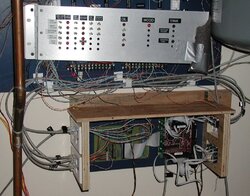I have been using an onboard zone/pump/boiler controller from a Saturn boiler - controls up to 4 zones.
I want move the controls outside of the boiler (possible replacement) and eventually move to a TS-7260 controller like nofossil.
Questions:
1. What exactly do I need to control a 24V zone valve?
2. What exactly do I need to control a 120V pump?
I know I need a 24V transformer, but do I need a 24V relay for each zone to be controlled by a thermostat or aquastat?
Can someone provide me a good reference?
I use nofossil's site as "the" reference, but I am missing the basics - how to switch a zone valve or circulator on based on thermostat or aquastat signal - eventually a 7260 signal.
Thanks,
Steve
I want move the controls outside of the boiler (possible replacement) and eventually move to a TS-7260 controller like nofossil.
Questions:
1. What exactly do I need to control a 24V zone valve?
2. What exactly do I need to control a 120V pump?
I know I need a 24V transformer, but do I need a 24V relay for each zone to be controlled by a thermostat or aquastat?
Can someone provide me a good reference?
I use nofossil's site as "the" reference, but I am missing the basics - how to switch a zone valve or circulator on based on thermostat or aquastat signal - eventually a 7260 signal.
Thanks,
Steve



